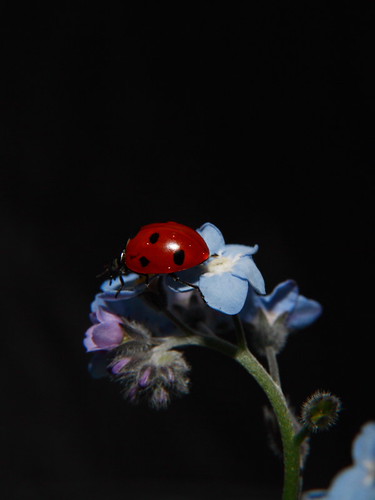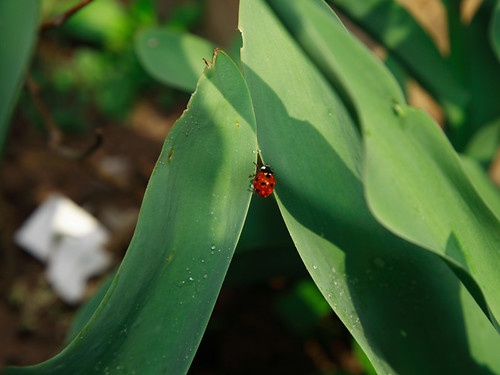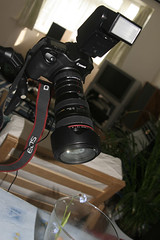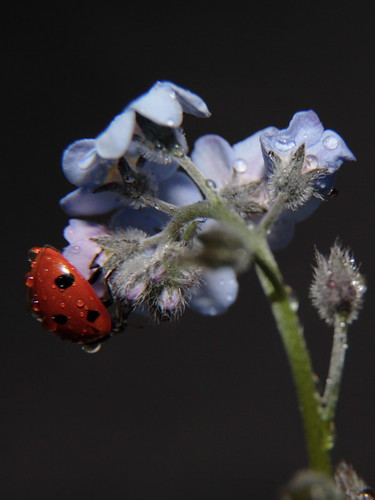Macro Photography

0.005sec (1/200); f/13; Focal Length:105 mm; ISO Speed:640;Exposure Bias:0 EV;Flash fired; using 12 and 20mm extension tube
Received Kenko extension tube set this week. Today I have a play with it.
My favourite subject is ladybird. Though very small, it is a very beautiful beetle with bright red shell doted. The size–about 5-7mm-presents a serious challenge for macro photography.
Back earlier April, I used Macro function comes with the lenses for close up shooting, which can be manually focus (with moving camera back and forth) at around 0.45m distance. The finished shoots after crop and interpolation(up size of the digital image by calculated and filling the pixels) become blur at edges. This is understandable-the finished photo I used as desktop is actually 4 times the life size by digital up scaling, counting the actual projection size of the beetle on the CCD sensor(or film emersion) it is much smaller. Later I will show you image magnification ratio chart.

0.005sec (1/200); f/9; Focal Length:105 mm; ISO Speed:100;Exposure Bias:0 EV;Flash No; Using Macro function
It must be optical magnification to solve the problem properly rather than resize the digital image. There are few solutions around, such like use reverse ring to mount a 50mm lenses reversely. Use a bellow or an extension tube. Each solution has its pros and corns.
Reverse ring is the cheapest solution. you can pick up one from eBay for around £5 including postage from China. It exposed the lenses inside out, without proection to the lenses element it could be a hazardous. And of course you lost TTL metering and auto focus.
Bellow is the most flexible but quite bulky. It takes a platform with ruler and guiding rails. I feel it is not the best choose for field shooting. I saw one on eBay going for £160 with a compliment 50mm FD lenses. A new one without lenses shipped from China costs about 30 pounds includes p&p.
That leaves candidate extension tube. By mounting it ( or combine a few and) to camera body, then mount lenses to it, you have the balance of flexibility, portable and lenses protection.
There are two types of extension tubes around. The economical one costs around £10 pounds, it doesn’t come with electronic contact points, so the camera and your AF, TTL lenses are disconnected. The one I brought made by Kenko comes with build-in contact points, it relays the communication between lenses and camera body. So it retains TTL metering and auto focusing. Costs £55 pounds from HK. About the price I paid for a 50mm 1.8F prime lenses. Consider there is no lenses, no motor and no circuit board but just 3 aluminium rings, it is quite expensive.
shown with 12, 20 and 36mm extension tubes mounted (See the red dots behind the lenses?)
Anyway I am quite excited to have a new gadget under my belt.
Global warming speeds up this Spring. Back three weeks ago there are a lot of ladybirds around our garden, now they all seemed gone away. So it is very lucky I found a fella basking sun in the grass.
First I mounted a 25mm tube and set our little friend to a tulip leave. Didn’t use flash as the sunlight was still strong. Auto-focus is usable, but not very useful as the field of depth is very shallow regardless aperture: a little motion from the subject will mean refocusing. And the auto focusing is just not fast enough to cope. The strong wind didn’t help neither. With the magnifying effect from the tube, it renders subject violent movement.
After a few attempts, I retreated. Took my little model with the stem he is resting on and set the shooting studio over dinning table.
I use flash mounted with diffuser. First I try 25mm, then 25mm plus 12mm and finally 25mm plus 12mm plus 36mm. At the beginning I didn’t bother to set up tripod, thinking with speed at 1/200 and image stabiliser, it should be alright without – I was wrong, later I checked the photos and found there are compromised on quality.
With all three tubes mounted, the Maginification ratio increased to 6.1 for a 50mm lenses. I zoomed to around 100mm so the shake from the hands were even apparent. So a tripod is a must. In fact I use release cable and set the custom function to enable mirror lockup.
0.005sec (1/320); f/9; Focal Length:105 mm; ISO Speed:400; Exposure Bias:-1EV;Flash No; Using 20mm extension tube

0.005sec (1/320); f/9; Focal Length:105 mm; ISO Speed:400; Exposure Bias:-1EV;Flash fired; Using 12, 20 and 36mm extension tube
After shooting, I resize the photo to be the same as the CCD size - for Canon 5D it is 23.84 x 35.8mm then measure the beetle’s size then compares to it is actual size: 6mm. Here is the actual magnification ratio chart:
(Setup) (CCD Projection size) (Mag. ratio)
macro: 2.8mm 0.467
12,20 36mm ex.tube: 8.5mm 1.417 (approx.)
12 and 20mm ex.tube: 7.6mm 1.267
20mm ex.tube: 3.75mm 0.625 (approx.)
P.S. Also found Cannon 5D handles high ISO noise quite well. With noise reduction switch on, it only becomes visibly grainy at 1000 or above.
